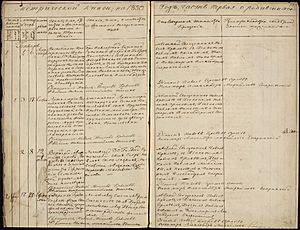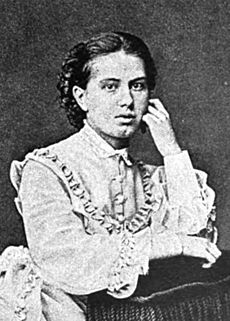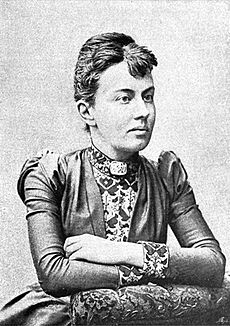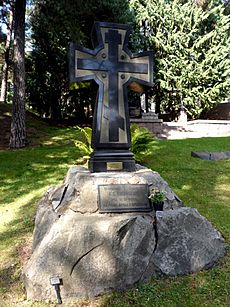Sofya Kovalevskaya facts for kids
Quick facts for kids
Sofya Kovalevskaya
|
|
|---|---|
| Софья Ковалевская | |

Kovalevskaya in 1880
|
|
| Born |
Sofya Vasilyevna Korvin-Krukovskaya
15 January 1850 Moscow, Russia
|
| Died | 10 February 1891 (aged 41) Stockholm, Sweden
|
| Resting place | Norra begravningsplatsen |
| Other names |
|
| Alma mater | University of Göttingen (PhD) |
| Known for | |
| Spouse(s) | Vladimir Kovalevskij (m. 1868; died 1883) |
| Children | Sofia (1878) |
| Scientific career | |
| Fields | Mathematics, Mechanics |
| Institutions | |
| Thesis | (1874) |
| Doctoral advisor | Karl Weierstrass |
Sofya Vasilyevna Kovalevskaya (Russian: Софья Васильевна Ковалевская) was a brilliant Russian mathematician. She was born Sofya Vasilyevna Korvin-Krukovskaya on January 15, 1850. She made big contributions to math, especially in areas like analysis, partial differential equations, and mechanics.
Sofya was a true pioneer for women in science around the world. She was the first woman to earn a doctorate (a high-level university degree) in mathematics. She was also the first woman to become a full professor in northern Europe. Plus, she was one of the first women to work as an editor for a science journal. Many people, like science historian Ann Hibner Koblitz, believe she was the most important woman scientist before the 1900s.
Historian Roger Cooke admired her greatly. He wrote that Sofya showed amazing courage and determination. She entered the world of university studies, where almost no women had gone before. People watched her, expecting her to fail. But she achieved major results that are still important today. This shows her incredible talent and hard work.
Sofya's sister was Anne Jaclard, who was involved in social movements. Sofya herself used the name Sophie Kowalevski (or sometimes Kowalevsky) in her published math papers.
Contents
Early Life and Education
Sofya Kovalevskaya was born in Moscow, Russia. She was the second of three children. Her father, Vasily Vasilyevich Korvin-Krukovsky, was a general in the Russian army. When Sofya was eight, her family moved to their country estate called Polibino.
Her mother, Yelizaveta Fedorovna Shubert, came from a family of German scientists. Her great-grandfather, Friedrich Theodor Schubert, was an astronomer. Her grandfather, Theodor Friedrich von Schubert, was also a general and a scientist.
Sofya's parents made sure she had a good education at home. She had teachers who spoke English, French, and German. When she was 11, she saw something amazing. The walls of her room were covered with old math notes from her father's student days. This sparked her interest in calculus, a type of advanced math. She also had a private math tutor named Iosif Ignatevich Malevich.
A physicist named Nikolai Nikanorovich Tyrtov noticed Sofya's special talent. She was able to understand a complex math textbook on her own. Tyrtov called her a "new Pascal" (a famous mathematician). He suggested she study more with N. Strannoliubskii. In 1866-67, she studied calculus privately with Strannoliubskii in St. Petersburg. He was a strong supporter of women getting higher education.
New Ideas and Challenges
During this time, Sofya's sister Anna learned about new ideas from a movement called "Russian nihilism." For young Russians in the 1860s, "nihilist" didn't mean something negative. It meant they believed in using science to make life better for everyone. They saw science as a way to find truth, make progress, and bring about social change. So, for them, studying science was a way to help society.
Even with her clear math talent, Sofya couldn't finish her education in Russia. At that time, women were not allowed to attend universities in Russia or most other countries. To study abroad, Sofya needed written permission from her father or a husband.
So, in 1868, she entered into a "fictitious marriage" with Vladimir Kovalevskij. He was a young student of ancient life forms (paleontology) and a book publisher. This marriage was just so she could travel and study. Vladimir was also the first person to translate and publish the works of Charles Darwin in Russia. In 1869, they moved to Germany to continue their studies.
University Studies in Europe
In April 1869, Sofya and Vladimir went to Heidelberg, Germany. Sofya worked hard to get permission to attend classes at the University of Heidelberg. She studied physics and mathematics with famous professors like Hermann von Helmholtz and Gustav Kirchhoff. Meanwhile, Vladimir went to another university to get his doctorate in paleontology.
In October 1869, Sofya visited London with Vladimir. She met famous writers like George Eliot and Herbert Spencer. At a gathering, she even debated Spencer about whether women could think deeply about abstract ideas. She had just finished a course on mechanics, so she was well-prepared!
Studying with Karl Weierstrass
In October 1870, Kovalevskaya moved to Berlin. The university there would not let women attend classes, even as visitors. So, she began taking private lessons with Karl Weierstrass, a very important mathematician. He was amazed by her math skills. For three years, he taught her the same material he taught his university students.
In 1871, Sofya briefly went to Paris with Vladimir to help during the Paris Commune, a revolutionary government. Her sister Anyuta was very active there. After the Commune fell, Anyuta and her husband were arrested. Sofya and her father helped them escape.
Kovalevskaya returned to Berlin and continued her studies with Weierstrass. In 1874, she submitted three important papers to the University of Göttingen for her doctorate. These papers were about partial differential equations, the movement of Saturn's rings, and elliptic integrals. With Weierstrass's help, she earned her doctorate in mathematics with the highest honors. She was even excused from the usual oral exams.
This made Sofya Kovalevskaya the first woman to receive a doctorate in mathematics in the modern sense. One of her papers included what is now called the Cauchy–Kovalevskaya theorem. This theorem helps prove that solutions exist for certain types of math problems.
Later Life and Achievements
After getting her doctorate in 1874, Sofya and Vladimir returned to Russia. Vladimir couldn't get a job as a professor because of his political views. Sofya couldn't even be considered for such a job because she was a woman. They tried different ways to earn money, but they faced financial problems.
In 1875, Sofya and Vladimir decided to live as a real married couple for a few years. Their daughter, Sofia (called "Fufa"), was born three years later. After spending time raising her daughter, Sofya left Fufa with relatives and friends. She then went back to her math work and left Vladimir for good. Vladimir, who had struggled with his moods, became more unwell and died in 1883.
That same year, a mathematician named Gösta Mittag-Leffler helped Sofya. He had been a fellow student of Weierstrass. He helped her get a job at Stockholm University in Sweden. She became a "privat-docent," which is like an assistant professor. There, she became close friends with Mittag-Leffler's sister, Anne Charlotte Edgren-Leffler, who was a writer.
In 1884, Kovalevskaya became an Extraordinary Professor (like an assistant professor today) and an editor for a math journal called Acta Mathematica. In 1888, she won a big award, the Prix Bordin, from the French Academy of Sciences. This was for her work on how a heavy object spins around a fixed point. Her discovery is now famous and called the "Kovalevskaya top." It was one of only a few known examples of how such objects move in a way that can be fully understood mathematically.
In 1889, Kovalevskaya was made a full professor at Stockholm University. She was the first woman in Europe in modern times to hold such a high position! After a lot of effort and changes to the rules, she also became a member of the Russian Academy of Sciences. However, she was never offered a professorship in Russia.
Sofya Kovalevskaya was also interested in politics and women's rights. She wrote several non-math books, including her childhood memories called A Russian Childhood. She also wrote two plays and a novel called Nihilist Girl.
In 1889, she fell in love with Maksim Kovalevsky, a distant relative of her late husband. But she didn't want to marry him because she felt it would stop her from doing her work.
Sofya Kovalevskaya sadly died in 1891 at age 41 from the flu, which led to pneumonia. She is buried in Sweden. Her important math discoveries and her role as a pioneering woman in a field mostly dominated by men have made her the subject of many books and studies.
Honoring Sofya Kovalevskaya
Many things have been named after Sofya Kovalevskaya to honor her achievements:
- The Sonya Kovalevsky High School Mathematics Day helps encourage girls to study math.
- The Kovalevsky Lecture highlights the important work of women in applied math.
- The Kovalevskaia Fund supports women in science in developing countries.
- A crater on the Moon is named Kovalevskaya.
- Schools in Lithuania and Russia are named after her.
- The Alexander Von Humboldt Foundation gives out a Sofia Kovalevskaya Award to promising young researchers.
- Streets in Saint Petersburg, Moscow, and Stockholm are named in her honor.
- In 2021, a satellite called "Sofya" was launched into space.
Sofya in Film and Books
Sofya Kovalevskaya's life has inspired several films and books:
- Sofya Kovalevskaya (1956), a film directed by Iosef Shapiro.
- Berget på månens baksida ("A Hill on the Dark Side of the Moon") (1983), a Swedish film.
- Sofya Kovalevskaya (1985 TV), a Russian TV film.
Her story has also been told in novels:
- Little Sparrow: A Portrait of Sophia Kovalevsky (1983) by Don H. Kennedy.
- Beyond the Limit: The Dream of Sofya Kovalevskaya (2002) by Joan Spicci, a biographical novel.
- She appears as a character in the novel Against the Day (2006) by Thomas Pynchon.
- The short story "Too Much Happiness" (2009) by Alice Munro features Kovalevskaya as a main character.
Images for kids
See also
 In Spanish: Sofia Kovalévskaya para niños
In Spanish: Sofia Kovalévskaya para niños








